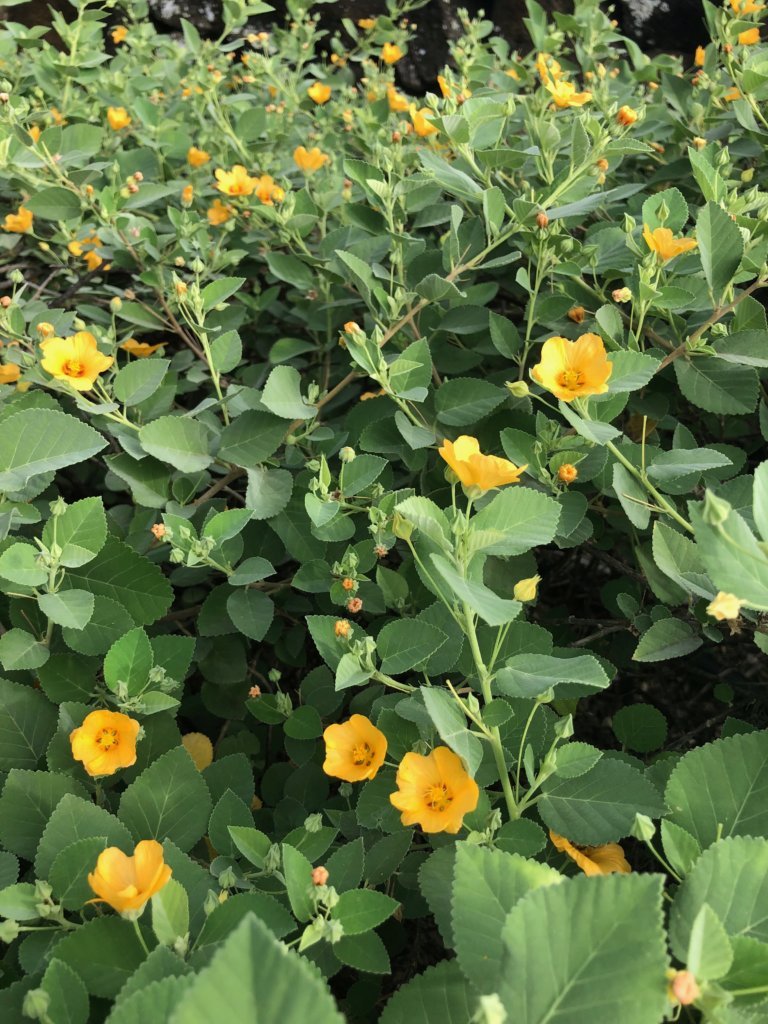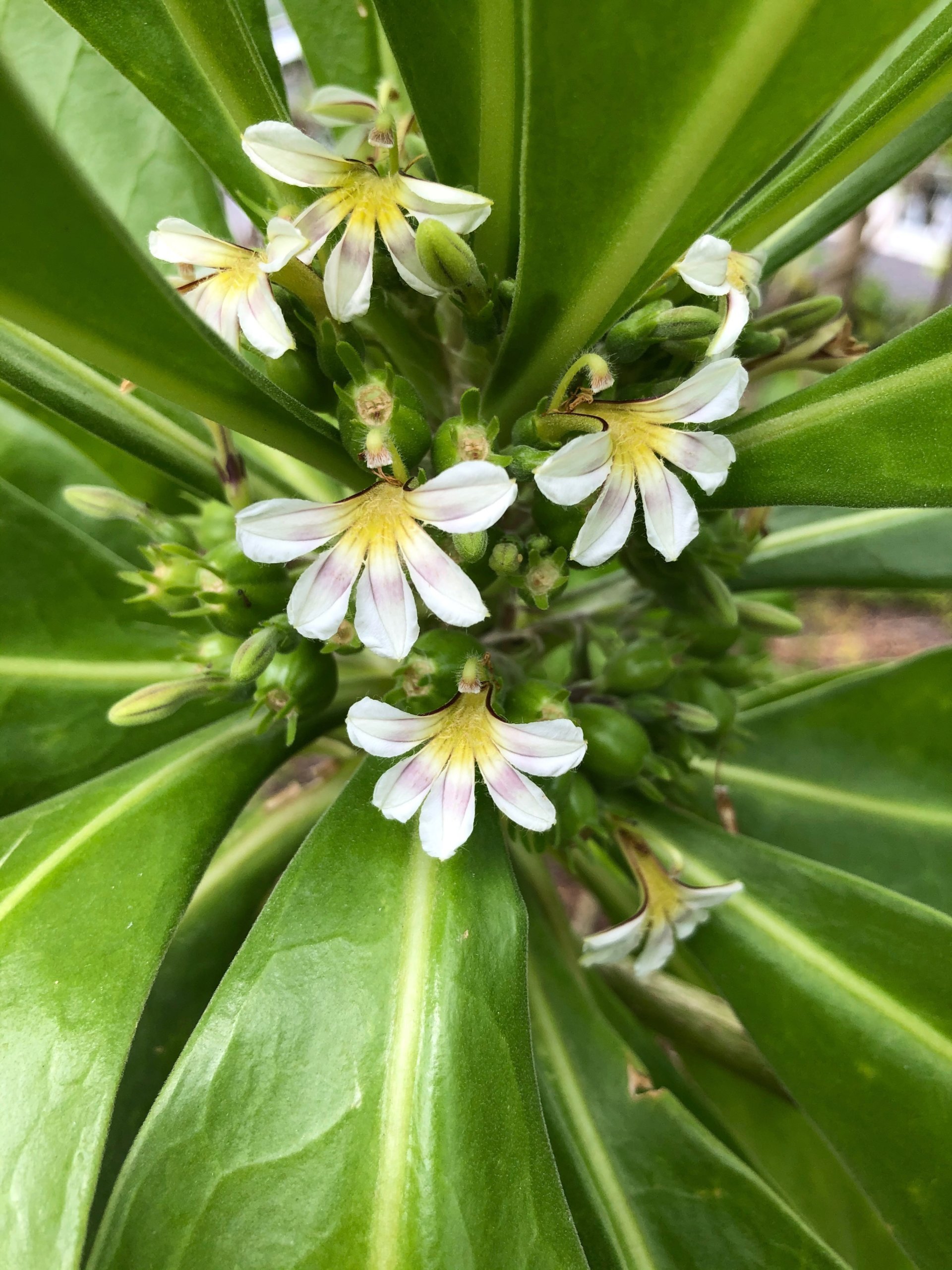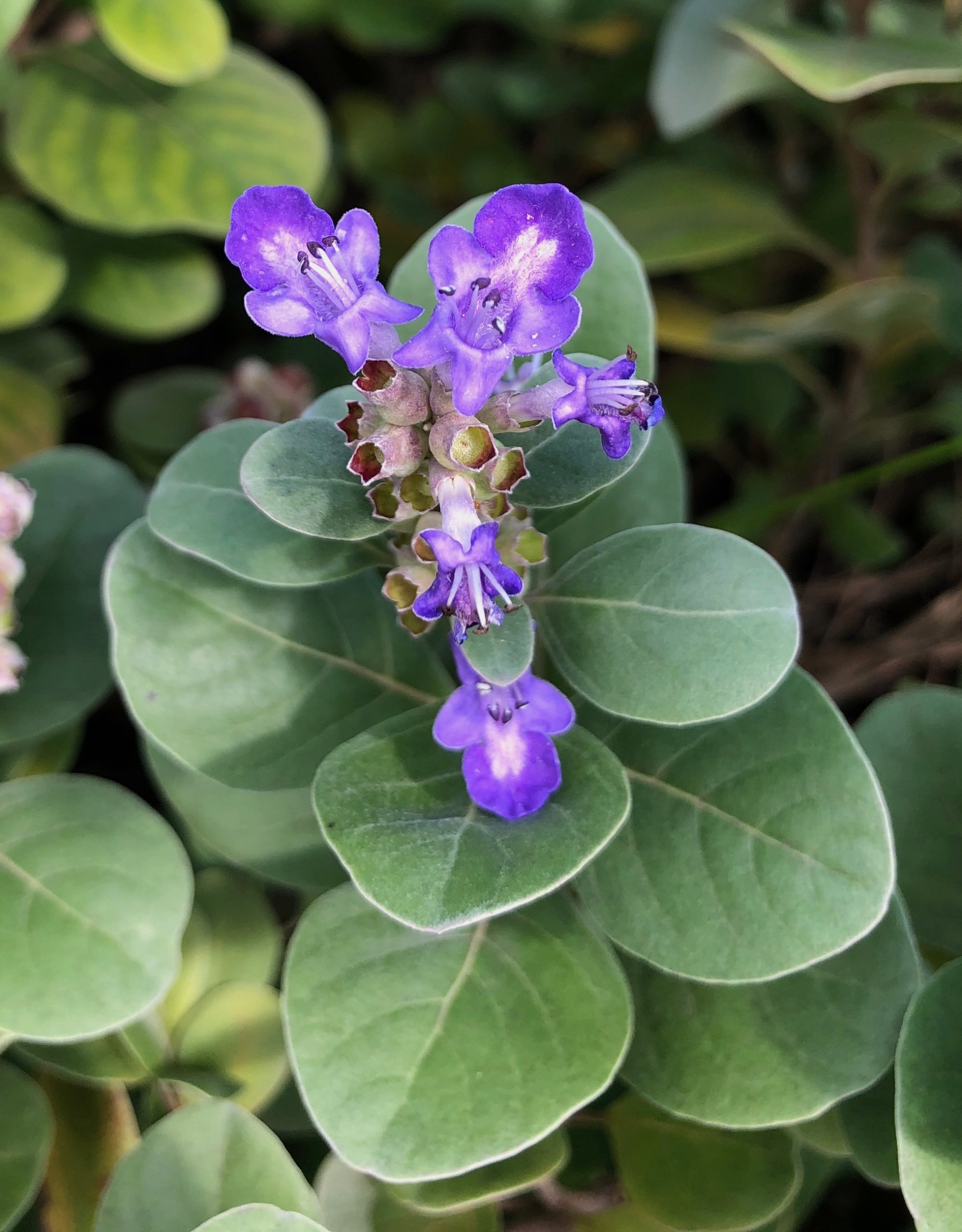Plant species
ʻIlima | Sida fallax
Distribution: ʻIlima is a common shrub or ground cover found on the coast and on up into the dry and mesic forest of all the Hawaiian Islands, this particular variety is found more in the mesic forests of Kauaʻi and Oʻahu. Other than that, ʻilima is classified as an indigenous plant so that means it is native to Hawaiʻi as well as other parts of the world.
Landscape Use: This plant makes an attractive low hedge or can be left alone as a specimen plant. Plant it in full sun to achieve maximum number of flowers and water less after plant shows signs of new growth. This will help the plant stay more bushier and not so leggy. Less watering will also increase the velvety look of the leaves and help keep the bugs away. ‘Ilima generally likes dry and hot conditions. Few pests are know to attack ‘Ilima, occasionally white fly may be found on the undersides of the leaves or aphids on the new leaves, a quick wash with a mild soap solution should help or following the label on a store bought pesticide for white fly and aphids will also work.
Cultural Uses: The flowers of ʻilima can be strung into lei and they are also used as a mild laxative for babies.
Additional Info: Today, ʻilima is known as the island flower of Oʻahu and is still strung into lei, but what people don’t realize is that you can add the flowers to your salads, they add great color and taste pretty good too. Make sure you pop out the flower from the calyx which is the little green cup at the base of the petals, just roll the calyx in between your fingers and the flower should pop right out. Don’t eat the flowers if you sprayed the plant with pesticides. If you did, read the label of the pesticide to see if you can eat from the plant after spraying and how long you should wait before you do.
ʻIlima papa | Sida fallax
Distribution: Naturally, ‘ilima papa is found on all the Hawaiian islands and many other places in the Pacific. All grow near the ocean in what is called the “strand vegetation” zone. Here the plants are exposed to extremely harsh conditions such as salt spray, wind, intense sun and heat, and drought. Because of this, the plants that occupy this vegetation zone have generally the same physical characteristics as mentioned above.
Landscape Use and Care: Plant ‘ilima papa as a ground cover anywhere that has full sun, is pretty dry and has non-clay soil. Space the plants about 1-1/2 to 2 feet apart. Do not over water. The best thing to do is to soak the ground and not water again until the soil has completely dried out. If you water too much, you’ll notice that the plants won’t be as prostrate and will get quite tall, especially if planted too close. Eventually the leaves will start to yellow, even drupe, which is a sign often mistaken for drying out so people add more water to the already drowning plant. If you notice this happening to your plant feel the soil first, if it’s still moist let it dry out. Bugs that sometimes feed on this plant are mealy bugs that are usually brought by ants, and whiteflies. Get rid of the ants with granular pesticide and treat the plant with any store bought pesticide that specifically kills mealybugs and whiteflies. Slugs and snails also like to live under ground covers so if you know your area has slugs or snails treat the area with slug and snail bait.
Uses: ‘Ilima is the island flower of Oʻahu and is used to make lei ‘ilima. The flowers can also be used as a mild laxative for babies. You can even put some in your tossed salad to add nice color by pinching them out of their calyxes (the small green cup that the petals emerge from), don’t worry about it being a laxative, it only works for babies. You would have to eat half a lei to make it work for adults but if you need to go then just keep pickin’.
Maʻo hau hele | Hibiscus brackenridgei subsp. molokaiana
Distribution: This is an endemic species found only in Hawaiʻi, it is also an endangered species with very few populations left in the wild. They are usually found in the dry to mesic forests of all the main islands except Niʻihau (it was once reportedly collected from Kahoʻolawe but now it no longer exists there).
Landscape Uses and Care: This plant does well in full sun to partial shade and needs very little water to thrive although daily watering is okay. It is a fast grower and will flower twice a year. Each flowering period lasts up to two months with blooms occurring daily on a flowering stalk that rises up above the rest of the plant. Unlike most hibiscuses, this plant doesn’t perform well as a hedge. Instead it looks best as a specimen plant. Rose beetles may attack the leaves of maohaohele at night and leave them looking like Swiss cheese. To prevent this, planting it near a light source at night should help. It seems that plants which are normally affected by rose beetles aren’t affected as much when they are either planted near landscape lighting or under a bright streetlamp or porch light. Leave the lights on from dusk until at least 8 or 9 at night and that should keep those nasty munchers away. Occasionally, whiteflies may be found under the leaves, any store bought pesticide should remedy that problem.
Additional Info: The name of this plant, maʻo hau hele, literally means the “traveling green hau”. It is probable that it got this name because after the plant gets to be about 3-5 years old it will become top heavy and either lean over or fall over and sprout new roots where the leaning branches touch the ground. Sometimes the old portion of the plant will die and the newly sprouted roots from the leaning branches will make the same plant thrive in a new spot a few feet over from its original location. Over time if the plant continues to flop over and sprout new roots it can move quite some distance. Sierra Club of Hawaiʻi founder, Lorin Gill, recalls a particular maʻo hau hele traveling over 20 ft in about 15 years! In 1988, the State of Hawaiʻi changed the state flower from the native red hibiscus (Hibiscus kokio) to this one. It should be made clear that this is the only species of yellow hibiscus that can be called our state flower, all other yellow hibiscus are not.
Naupaka kahakai | Scaevola gaudichaudiana; S. gaudichaudii; S. mollis
Distribution: This Native Hawaiian species is found throughout the tropics on the coast. Locally, naupaka can be found on practically every sandy or rocky beach.
Landscape Uses and Care: Naupaka kahakai makes a great hedge. Its natural habitat will tell you that this plant thrives in full sun and needs very little water once established in the ground. This plant can be shaped into a low hedge or groomed into a large hedge reaching over 10 feet tall. Planting them every 2 feet will ensure a thick and beautiful hedge. Very few pests bother this extremely hardy plant.
Additional Information: On sandy beaches, the wind-breaking effect of naupaka traps sand at their roots, forming a mound. Over periods of time, the continuing sand deposits turn into sand dunes.
Pohinahina | Vitex rotundifolia
Distribution: This is an indigenous plant, native to Hawaiʻi as well as other parts of the Pacific, even Japan. In Hawaiʻi it is found on sandy coasts of all the main islands except Kahoʻolawe, although it may have occurred there in the past.
Cultural Uses: The fragrant leaves of this plant can be layered between folded kapa to repel insects. The leaves and flowers can also be arranged in lei poʻo.
Landscape Uses and Care: An excellent plant for use in stabilizing soil. As it grows, the branches lean over and root at the nodes that are touching the ground. They make excellent ground covers for slopes that need help with erosion control. Generally, pōhinahina are quick growers and require very little water, they thrive in full sun. These plants respond well to pruning and can be formed into a low hedge; they also look great in pots for your lanai. To cover large areas, plant spacing of every two feet on center is close enough; they’ll fill in just fine. Few pests are known to bother this plant. It is hardy and easy to take care of. If you kill this plant then yes, your thumbs may be brown.
Additional Info: Besides pōhinahina, depending on which island you are on, this plant is also known as kolokolo kahakai, hinahina kolo, manawanawa, mawanawana, and polinalina.
Pualoalo | Hibiscus arnotiianus
Distribution: This exceedingly rare native white hibiscus is endemic to the mesic forests of Oʻahu in both the Koʻolau and Waiʻanae mountain ranges
Landscape Use: As with most hibiscuses, the pualoalo can be trimmed into a beautiful, highly colorful hedge or left alone to be admired as a specimen plant. It is very wind, sun and drought tolerant and is resistant to the unattractive bumps from gall mites that seem to plague most hybrid hibiscus. This is yet another perfect native plant for any garden. Hint: plant this plant in front of a dark background like a rock wall or ti hedge to really show off the flowers! Watch out for aphids and whitefly, if you do notice them treat the plant by either shooting them off with a water hose or spraying them with pesticide. If you follow the directions on the bottle you should have good results.
Cultural Uses: The flowers of hibiscus were eaten as a laxative and some sources say that the native red hibiscus were eaten by girls and women while the white hibiscus were eaten by boys and men. In addition the flowers were also strung into lei but today it is most often put behind the ear.
ʻUkiʻuki | Dianella sandwicense
Distribution: Indigenous, found in many different vegetation zones from lowland dry forests to higher wet forests. Found on all main Hawaiian Islands except Niʻihau and Kahoʻolawe, although they most likely occurred there in the past.
Landscape Use: This is one of the most durable plants you can have. It does well in practically any growing condition from full sun to practically full shade, outdoors to indoors, moderate water to little water, just about anything. Looks good as an accept plant around large boulders or at the base of larger plants and shrubs. The only pests to watch out for are white scales and mealybugs. If you notice them on the underside of the leaves, they can be manually removed by either shooting them off with water or by cleaning them off with your fingers using soapy water. Its flexibility to handle many types of environments makes this plant ideal for any landscape.
Cultural Uses: The leaves can be used for thatching while the berries of the short variation make a nice bluish-purple dye for kapa while the taller one usually makes a yellowish-brown dye. As delicious as the berries look, don’t eat them, they don’t taste ono at all and they turn your whole mouth blue.







